St. Catherine of Siena is counted among the thirty-seven Doctors of the Church and is one of the most respected and revered woman in all church history. She was a mostly-illiterate laywoman, a third-order Dominican who worked among the sick and poor. She is revered not only for her deep piety and spiritual wisdom, but for using her supernatural skills of persuasion to mediate conflicts among the most powerful men of the 14th century, ultimately persuading the Pope Gregory XI to return the seat of the church from Avignon to Rome. She lived only 33 years, but in that time exerted and outsized influence on the church, and continues to inspire through her Dialogues and letters.
Here's her head.
You see, the people of Siena loved Catherine, but she died in Rome and the Eternal City laid claim to her body. If you know anything about popular piety, and particularly about civic pride in the middle ages, you know that losing Catherine’s remains (certain to be the locus of her cult and shrine) was never going to do for the hometown crowd.
Thus, in the dead of night, they slipped in and removed her head, carrying it back to Siena and putting it in a nice shrine where it gently mummified over the years. There's even a miracle associated with its translation1: when the hometown team was asked by the guard in Rome to open the bag containing the head, he found only rose petals inside.
You might think this is a one-off story. Hahahaha! Oh, my sweet summer child.
No.
Pictured above is the heart of St. Teresa of Avila. When the city fathers of Avila won their struggle for the remains of the saint, one of the sisters assigned to watch over the body cut out her heart the night before it was moved. The heart remains in the convent in Alba de Tormes in Spain where she died.
There are more.2
There are two reactions to this:
1. Something is deeply wrong with you people.
2. Cool! That's metal as %$#&.
I am certainly a Number 2 person, as you can tell by the site you are reading at this very moment!
Number 1 is, of course, also completely true.
Introducing Relics
I’ve taught about the long and complex history and theology of relics over 20 years, and always considered it kind of the background hum of Weird Catholic. And yet, I've never written any kind of overview of the subject. I thought it was time.
I go about my weekly Weird Catholic business assuming you're all familiar with Elisha's bones, Paul's hankies, Gilbert of Nogent, The Martyrdom of Polycarp, Second Nicea, City of God Book 22, and so forth, forgetting that most people don't make a lifelong study of funerary practices and the veneration of human remains.3
So consider this the first in a series of occasional pieces on the Relics of the Saint. I plan to keep the approach somewhere between semi-scholarly and semi-casual, hopefully finding that sweat spot where education doesn't stop being entertaining and yet doesn't become tasteless, although of course De gustibus non est disputandum.
"There is such a thing as good-bad taste
and bad-bad taste."
John Waters
Consider yourself warned.
Relics Before Christianity
Throughout history, most cultures attached importance to the remains of their honored dead, and often this meant keeping parts of them, or things belonging to them, in shrines. This is distinct from the cult of the dead as it existed in megalithic religion and other traditions that practice ancestor worship. These were tied to several notions in primitive belief, such as passage to the afterlife, agricultural renewal, fertility, and the ability of the dead to continue helping the living. 4
This accounts for not only various funerary customs, but also the development of ritual and early religious thought. Furthermore, it represents an odd paradox: funerary practices and the cult of the dead sought to remember the departed, seek their help, and assist their journey, while at the same time separating them from the living and proscribing their freedom of motion. The dead were both loved and feared. A grave marker or monument not only served as a locus of worship and a proxy body (the dead were sometimes thought to occupy the stone itself), but they also indicated places to avoid in certain seasons of liminality.
There have always been “special” dead, however: departed souls considered by the community to be venerable, sanctified, and even capable of conveying sanctification. These are the people we call saints, but there are similar examples across history and cultures.
The Greeks supposedly venerated an egg laid by Leda5, the remains of Oedipus, and according to Plutarch the remains of Demetrius, Phocion, Aesculapius, and Theseus were transported and regarded with honor. Plutarch gives us a sense of this in his life of Theseus:
And after the Median wars, in the Archonship of Phaedo6 when the Athenians were consulting the oracle at Delphi, they were told by the Pythian priestess to take up the bones of Theseus, give them honorable burial at Athens, and guard them there. But it was difficult to find the grave and take up the bones, because of the inhospitable and savage nature of the Dolopians, who then inhabited the island. However, Cimon took the island...and being ambitious to discover the grave of Theseus, saw an eagle in a place where there was the semblance of a mound, pecking, as they say, and tearing up the ground with his talons.
By some divine ordering he comprehended the meaning of this and dug there, and there was found a coffin of a man of extraordinary size, a bronze spear lying by its side, and a sword. When these relics were brought home on his trireme by Cimon, the Athenians were delighted, and received them with splendid processions and sacrifices, as though Theseus himself were returning to his city. And now he lies buried in the heart of the city, near the present gymnasium, and his tomb is a sanctuary and place of refuge for runaway slaves and all men of low estate who are afraid of men in power, since Theseus was a champion and helper of such during his life, and graciously received the supplications of the poor and needy.
The chief sacrifice which the Athenians make in his honor comes on the eighth day of the month Pyanepsion, the day on which he came back from Crete with the youths. But they honor him also on the eighth day of the other months, either because he came to Athens in the first place, from Troezen, on the eighth day of the month Hecatombaeon, as Diodorus the Topographer states, or because they consider this number more appropriate for him than any other since he was said to be a son of Poseidon.7
As for the ship of Theseus, it isn't just a paradox for philosophy students: it was a genuine relic which philosophers were already debating in the time of Plutarch:
The ship on which Theseus sailed with the youths and returned in safety, the thirty-oared galley, was preserved by the Athenians down to the time of Demetrius Phalereus.8 They took away the old timbers from time to time, and put new and sound ones in their places, so that the vessel became a standing illustration for the philosophers in the mooted question of growth, some declaring that it remained the same, others that it was not the same vessel.
Obviously, mummification and the tombs of the pharaohs have aspects of relic veneration, but the elaborate rituals surrounding death had more to do with passage to the next world than ongoing worship. The earthly deification and posthumous apotheosis of rulers was part of an elaborate political, religious, and social matrix that was markedly distinct from notions of the honored dead, although as we will see the saints of Christendom were—sometimes accidentally, sometimes deliberately—used to displace deified leaders and local gods.
Due to their time in Egypt, the Jews may have been reacting to the excesses of mummification rituals when developing the strict purity codes about dead bodies. Although there were certainly tombs of patriarchs and kings, these did not sustain any kind of cultus among the Jews, and indeed they are almost unique among ancient cultures in their approach to the dead.
Christianity radically changed this understanding of death and the dead for a very simple reason: the resurrection.
Relics in Other Religions
Of all the world religions, the one with the closest analogs to the Christian cult of the saints is Buddhism, which is odd when you consider its views on the impermanence of the physical world and the almost utter lack of a similar set of beliefs in Hinduism.
The body of the Buddha, Siddhartha Gautama, was cremated, and his remains were divided into eight portions and placed in reliquaries. In addition, the vessel that held the ashes and the remains of the pyre were also preserved. Shrines claiming various Buddhist relics exist in almost every form of Buddhism, and the main bone relics of the Buddha himself--such as teeth, a piece of collar bone, and so on--are venerated in various locations. These remains were highly valued, sometimes leading to clashes among rival claimants, or people seeking favor or power from possessing them. Some traditions even believe they will reform under the bodhi tree at the end of time.
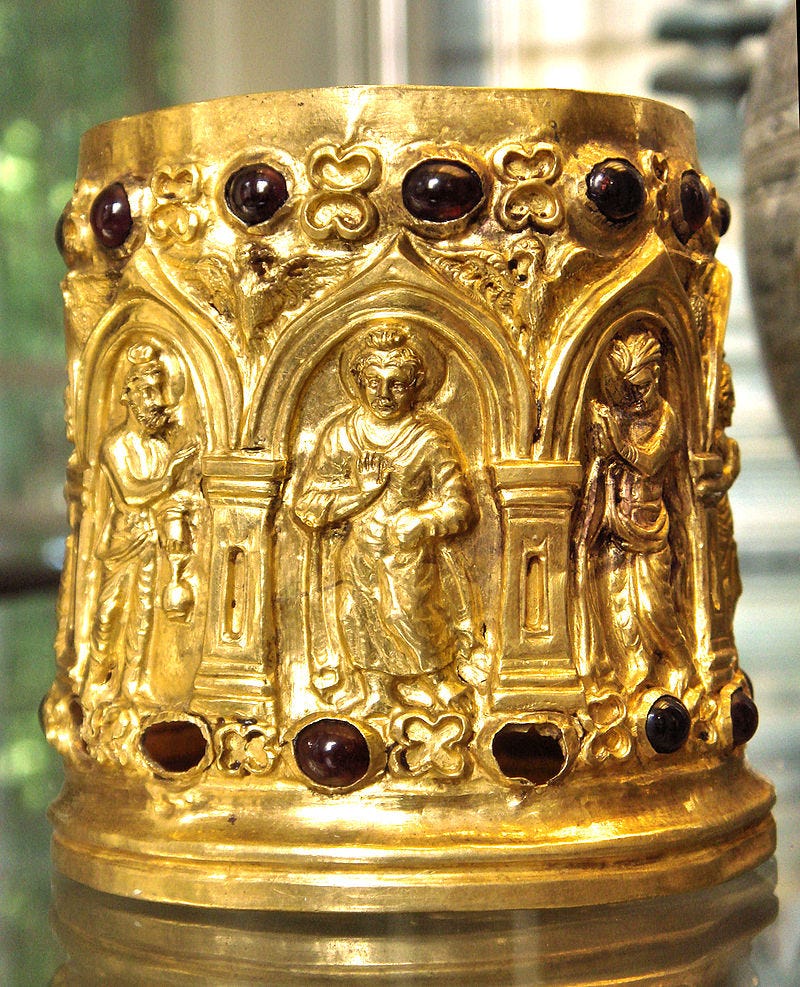
Other venerated figures in Buddhist history, such as his disciple Sariputra, were likewise preserved. Indeed, his remains were excavated in the 19th century, and subsequently lost.
In 2015, a one-thousand year old Chinese statue was subjected to CT scanning and found to contain the mummified body of a Buddhist monk named Liuquan. The mummy was likely venerated for two centuries before it was enclosed in the reliquary sometime in the 1300s.
Islam also has a tradition of relic veneration, although some schools of thought condemn it outright. Muhammad's battle standard, clothing, tooth, and even his beard were preserved and are regarded with reverence. Topkapi Palace in Constantinople claims the pot of Abraham, the staff of Moses, Joseph’s turban, David’s sword, pieces of John the Baptist as well as his scrolls, items from the Kaaba, and relics of Muhammad, including his swords, bow, banner, and mantle. All are regarded as sacred.
The cult of relics is fairly uncommon in Hinduism, although some leaders, such as Paramhansa Yogananda, were said to be incorrupt. The tradition of cremation does leave ashes, but they don’t tend to be saved or preserved. Given the vastness and variety of Hinduism, there are likely exceptions to this, but I’m unaware of any.
Protestants, particularly American protestants, tend to sniff at all this and believe it has no place in Christianity, although as we shall see it has roots in the Hebrew Scriptures, the New Testament, the early church, and the Fathers. Many of the same critics, of course, would treasure an autograph from a beloved celebrity or the jersey of a favorite athlete. They preserve hair from baby’s first haircut. They line up at museums to view artifacts of the famous and visit the graves of Presidents and other secular “saints.”
Shortly before my ordination, I made a pilgrimage of my own own to the city of Memphis, where the clothing, personal items, home, and tomb of America's most beloved son are preserved with a degree of care that would shame the most superstitious medieval peasant. The same Baptists who stood regarding the many jumpsuits of Elvis Presley with awe, who somberly bowed their heads as they filed past his grave, no doubt think Catholics are nuts for preserving the remains of God's holy ones.
I would argue that we are the ones who seem to really understand it.
Even now miracles are being worked
in Christ’s name,
either through his sacraments
or through the prayers
or relics of his saints.
Saint Augustine, The City of God9
The Future
This is the first in an occasional series about relics. Next up will be the Biblical context. I don’t know how frequently I’ll roll these out, but I expect to keep going until I run out of material. The posts will be indexed in a tab at the top of the page.
I am approaching the 7th Anniversary of WeirdCatholic.com and the 1st anniversary of my relaunch here on Substack, and am starting to plan for the future. This was supposed to be the preparation for an eventual book launch under this title, but the future of that is now uncertain.
I am a professional writer, but I don't like rattling the tin cup. Nothing has been paywalled up until now. This is not a hobby, however, and my writing income is severely curtailed by a the demise of the magazines where I earned my bread for several decades. The responsibilities I've taken on as part of my ministry also occupy a great deal of time.
Because of this, I plan to paywall some of the posts in this series, while also having generous previews for regular readers.
If people don't want to get into ongoing subscriptions but want to throw a few bucks in the tip jar or knit me a cardigan or send me an ice cream cake in the mail or something, let me know and I'll manually unlock a month or two. As usual, liking, subscribing, and sharing is always welcome.
When a relic is moved, it is called a “translation,” and is usually done is solemn procession, unless the Roman guards are nearby, in which case you just stuff the head in a bag, whisper an Ave, and hope for the best.
Pictured, in order from top: Teresa, Anthony, Valentine, Francis Xavier, Mary Magdalene.
Nor should they. Seriously, there's probably something wrong with a person who would do that. In fairness to me, it actually started with a childhood obsession with Egyptology. After my first encounter with a mummy, I was off to the races.
This all becomes more elaborate and shifts focus as religions develop gods of death, the dead, and the underworld, which are are a separate subject. I don’t want to get in the weeds with discussion of Osiris, Hades, Yama, and other religious aspects of death and the underworld. The cult of the saints, and the role of relics in it, is its own subject, separate from more general ideas about death and burial. Relics have a unique place in religions apart from that of more “ordinary” remains. The relic is, by its very nature, connected to someone special. What distinguishes Christianity from pagan belief about the dead, and what distinguishes both from the cult of the saints, will be one of my subjects going forward.
Allegedly kept in the sanctuary of the Leucippides at Sparta.
476–475 BC
Plutarch, Plutarch’s Lives, ed. Bernadotte Perrin (Medford, MA: Harvard University Press, 1914).
Regent of Athens for Cassander of Macedon, 317–307 BC.
Ed. Boniface Ramsey, trans. William Babcock, vol. 7, The Works of Saint Augustine: A Translation for the 21st Century (Hyde Park, NY: New City Press, 2012–2013), 506.





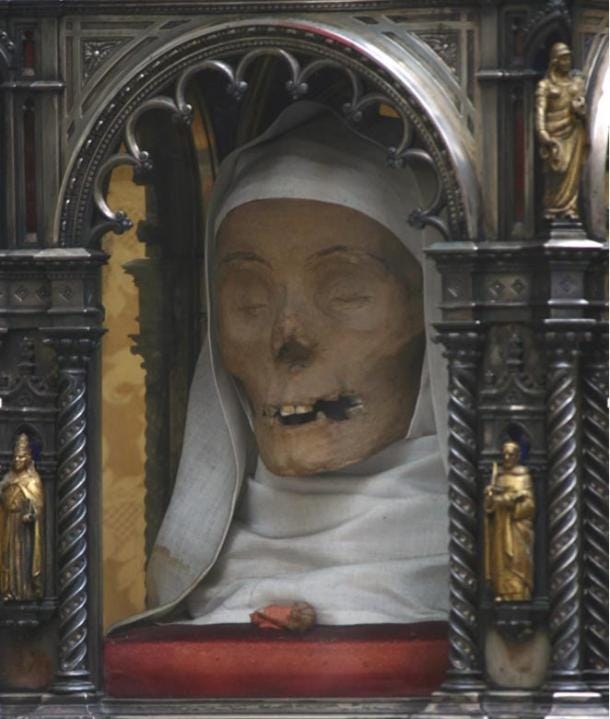
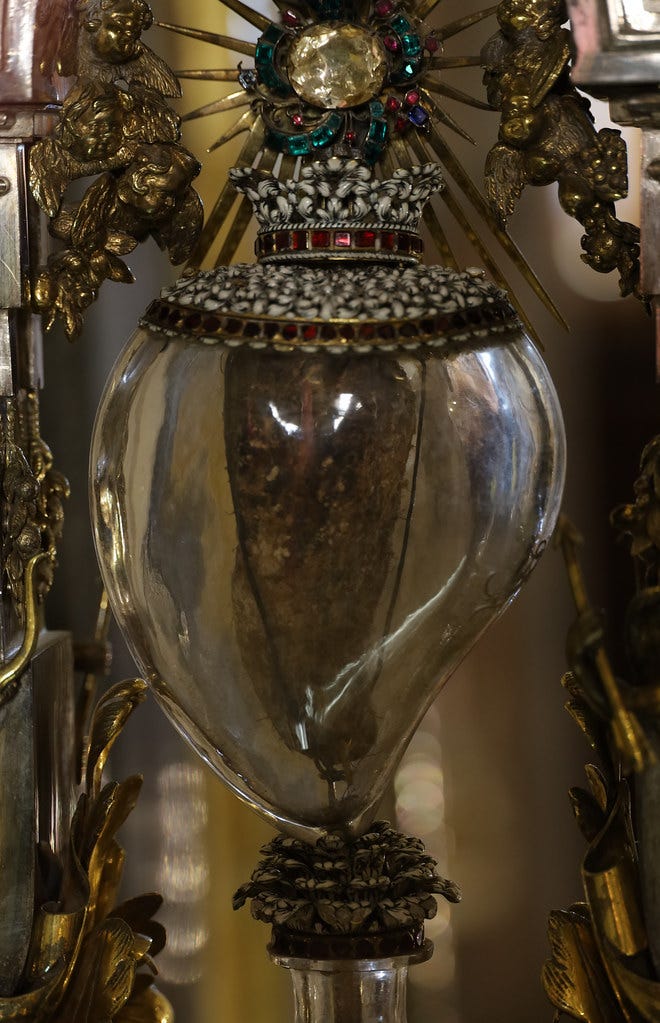
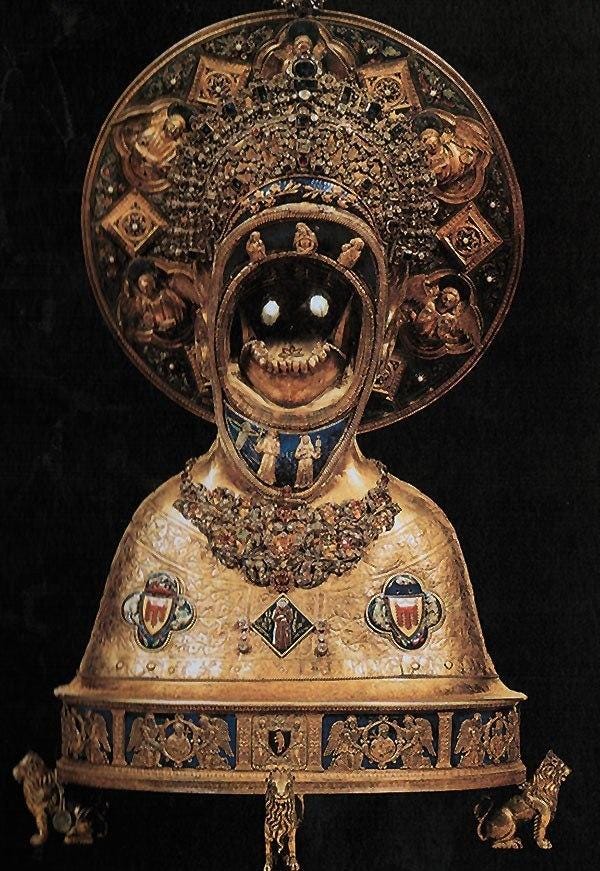



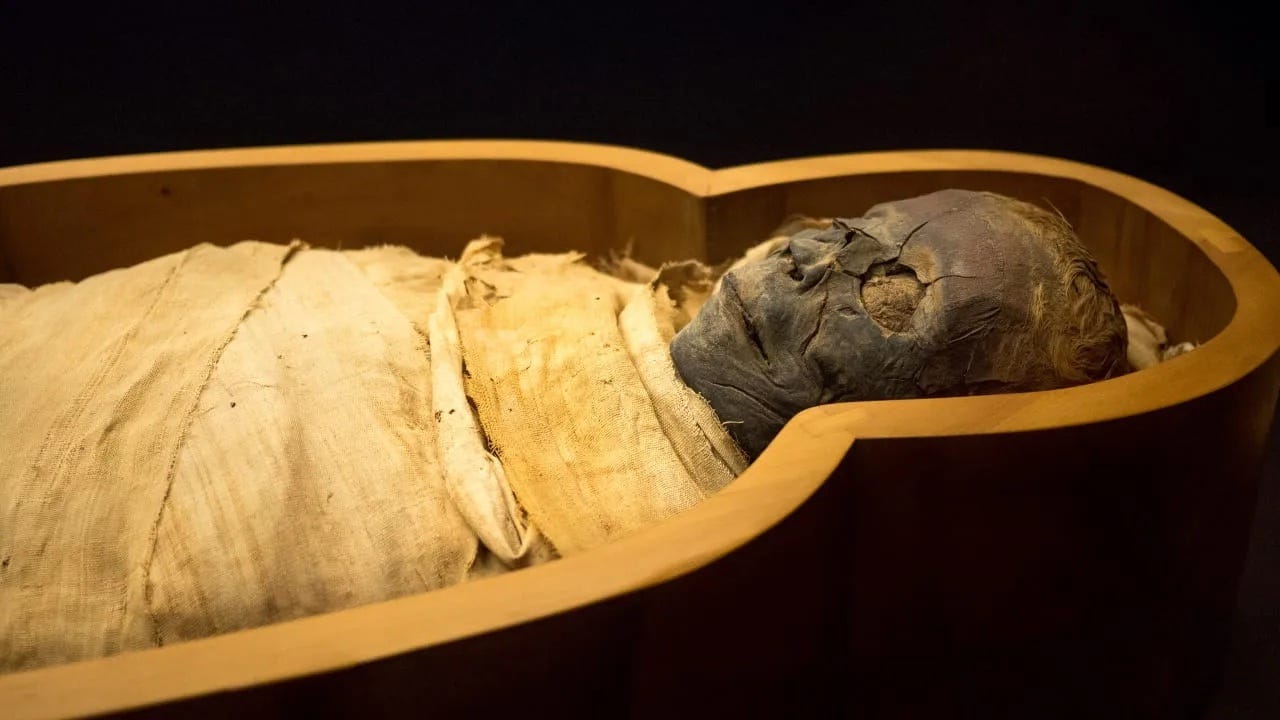



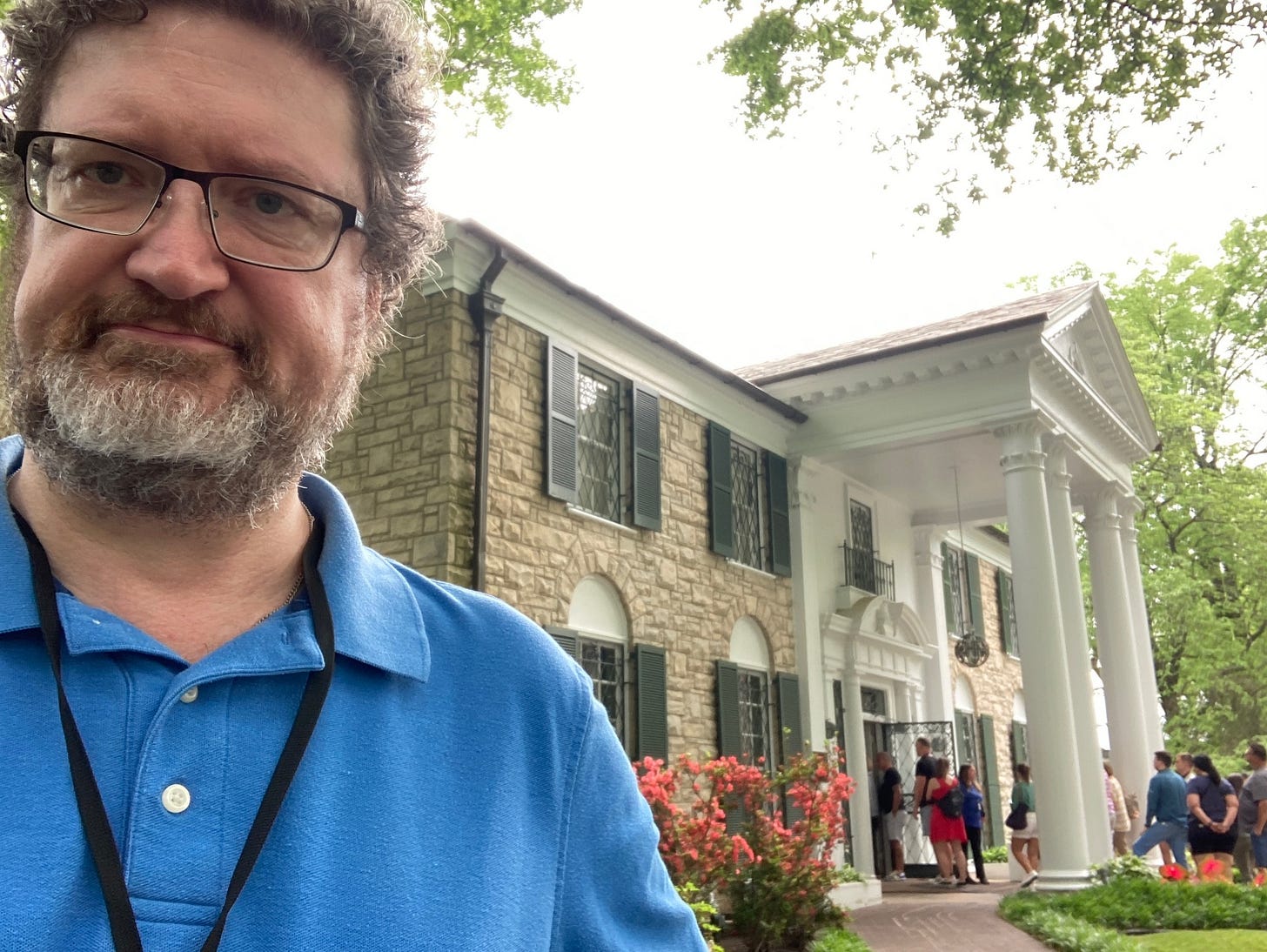
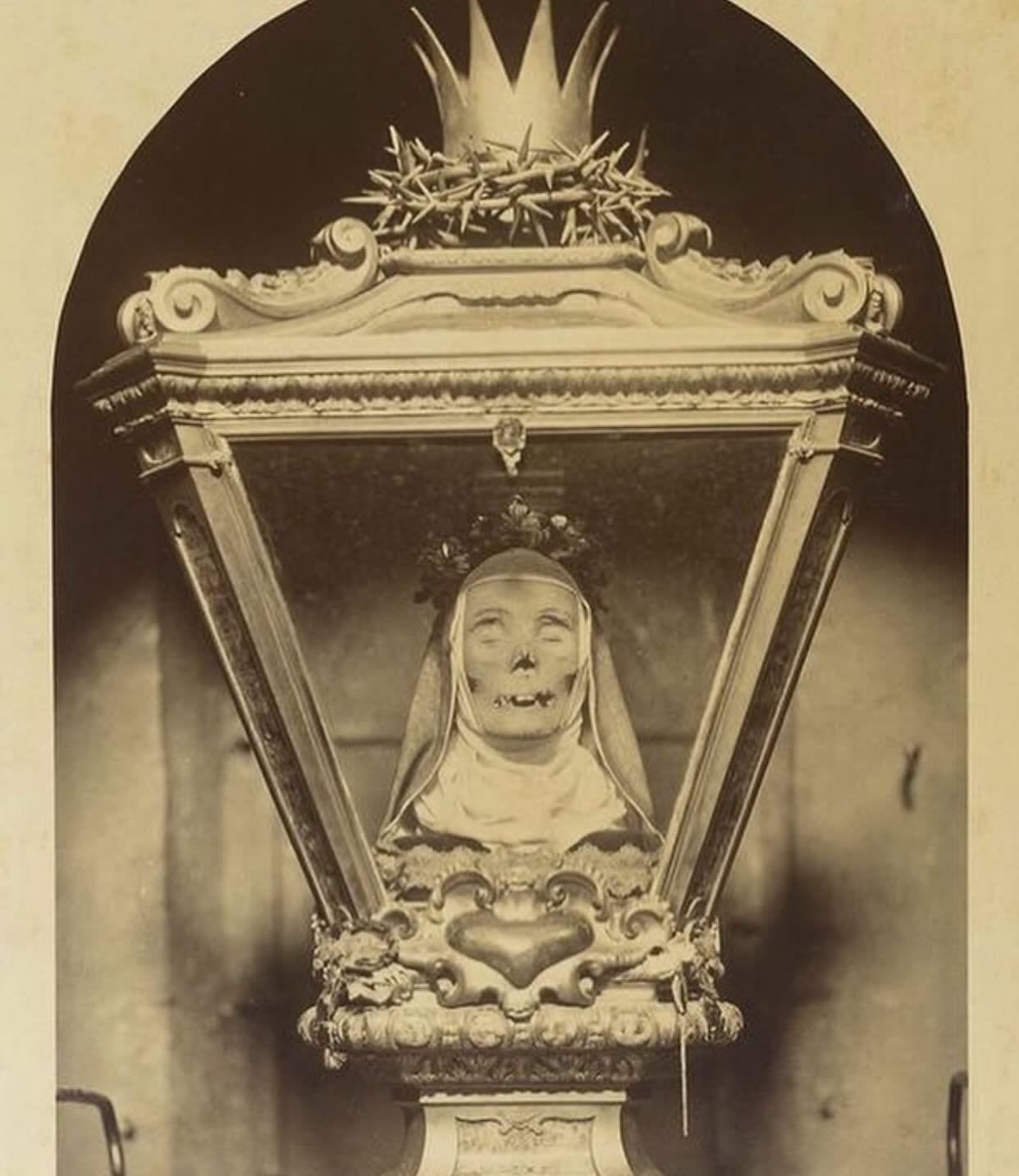

It seems that keeping parts of our beloved ancestors whether true ancestors or ancestors in the faith spans cultures and religious traditions. It’s only in our time where people seem so bent on denying death, a basic reality of life, that we think such practices are wacky. I’m glad that human experience down through the ages has recognized that you can’t run from death or deny it out of existence. The veneration of saints including their relics is so important because it is a visible sign of the naturalness of death, and the presence of God’s holiness within an incarnate world.
Hilarious AND educational.